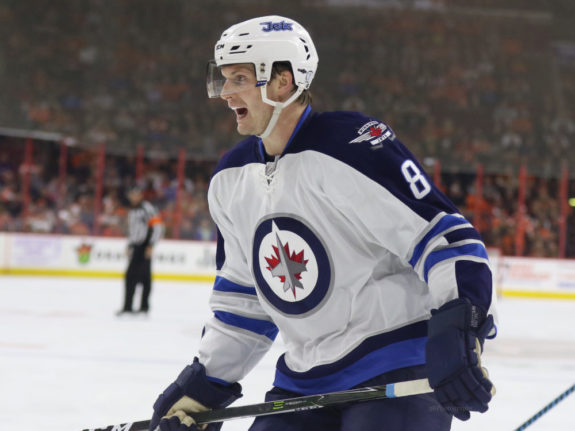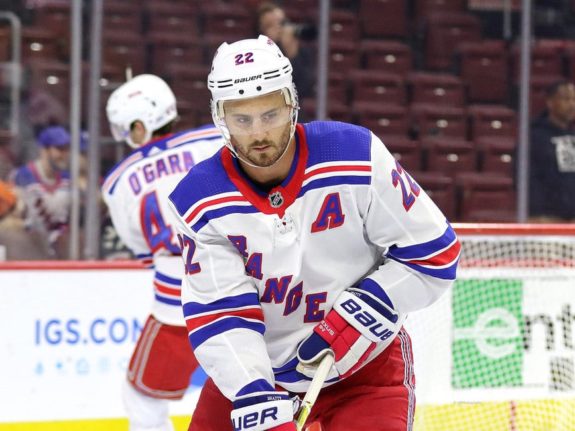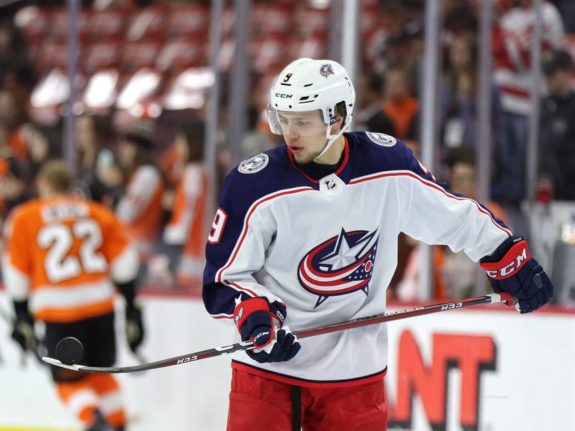Still basking in the glow of Monday’s stunning heist of defenseman Jacob Trouba from the Winnipeg Jets, the New York Rangers can continue what looks to be a special offseason Friday when they select Jack Hughes or Kaapo Kakko with the second overall pick in the draft. General manager Jeff Gorton can figuratively put his feet up for that selection – he’ll simply take whichever elite forward talent the first-overall New Jersey Devils don’t.
If the Rangers want to turn their summer into an epic one, though? In that case, Gorton needs to roll up his sleeves and get to work.
Adding free-agent star Artemi Panarin on July 1, if he is indeed serious about his interest in Broadway, will require some roster reshuffling in order to clear significant room under the salary cap.
The Rangers might be days away from inking Trouba, the 25-year-old first pair defenseman they acquired (stole) from the Jets for the 20th overall pick (Originally Winnipeg’s before being sent to the Blueshirts in the Kevin Hayes deal) and defenseman Neal Pionk, to a seven-year contract in the neighborhood of $8 million per year.

That hypothetical number would jump the Rangers’ cap number to $68 million for a season in which the threshold is expected to rise to the $83 million range. Next, the front office will need to account for the desired re-signings of key restricted free agents Pavel Buchnevich, Brendan Lemieux and Tony DeAngelo – which figures to cost around $10 million.
That’s $78 million under an $83 million cap (the exact number has yet to be announced). Panarin, of course, isn’t taking his talents to Broadway for $5 million. The Rangers will likely have to offer him $10-11 million a year to compensate if his former coach Joel Quenneville and the Florida Panthers, who play in a no-income-tax state, are serious about making a run at the winger.
So making the math work for Panarin is going to require Gorton to get his hands dirty.
Shattenkirk’s Days in a Blueshirt Numbered?
The most obvious potential starting point is a buyout of Kevin Shattenkirk, whose massively disappointing New York homecoming is scheduled to run two more years. At $6.65 million per season, cutting ties with the defenseman would create nearly $5.167 million of room for 2019-20 – though that drops to $567,000 in 2020-21.
Even that move won’t be enough if it takes $11 million per year to land Panarin, unless the Rangers plan on going into the season without the ability to add any significant players. So more would have to be done in the form of trades.
The candidates? Chris Kreider is of course at the top of that list – uncomfortably so for many fans. Dealing ‘Kreids’ is something the front office was going to consider anyway, with the team no longer able to put off the decision on whether to commit long-term to the enigmatic talent in the form of a deal that might average north of $6 million per year. With one year at $4.625 million remaining, moving on from Kreider – perhaps for a first-round pick, and perhaps as early as Friday night in Vancouver – would be a significant space-saver in concert with a Shattenkirk buyout.
Other trade options abound. Moving Jimmy Vesey ($2.275 million) and perhaps Ryan Strome ($3.1 million) and/or Vlad Namestnikov ($4 million), even if dealing the latter two require the Rangers to retain some of the salary, is on the table, although dumping all three along with Kreider would put the club’s forward depth in jeopardy.

Nevertheless, jettisoning Kreider, Vesey, Strome and Namestnikov ($13.64 million combined) for inexpensive future assets represents a possible alternate route to adequate Panarin space in lieu of a Shattenkirk buyout, even if the Rangers had to keep up to 50 percent of Strome’s and Namestnikov’s money. In that scenario, the Blueshirts would be back at approximately $68 million, this time with Trouba signed and nearly $15 million of room to pursue Panarin.
The problems with that, though, are multiple. First off, it assumes that Gorton can actually move those players. More importantly, signing Panarin for about $11 million in that hypothetical still results in a cap crunch. Is the GM ready to return to that already when his club is still supposedly in rebuilding mode – albeit accelerated after the acquisition of Trouba?
The Panarin chase needs to take into account the near future, even as he would sign on for a long-term stint with the Rangers. Possible future cornerstones Lias Andersson, Filip Chytil, Libor Hajek, Ryan Lindgren, Igor Shesterkin and Yegor Rykov become RFAs after 2020-21, Vitali Kravtsov and Adam Fox the season after that. The Rangers didn’t spend the past two years drafting/trading for all of those high-end young assets to not be able to sign at least most of them after their entry-level deals expire.
Despite Concerns, Rangers Should Go Hard After Panarin
The Rangers are set to gain north of $25 million in cap space after 2020-21 with the expiration of the deals of Shattenkirk, Henrik Lundqvist, Marc Staal and Brendan Smith, assuming they don’t buy out any of the three defensemen. That timing is certainly fortuitous, though the expectation is that their rebuild should have left the Rangers as at least rising contenders in the Eastern Conference by then. The $25 million won’t go nearly as far if the Rangers are looking to add more premium free agents to a supposedly rising team and re-up their gaggle of talented youngsters – and even less if dead money from one or more buyouts is added to the payroll.
A Shattenkirk buyout, for instance, would add about $1.433 million of dead space for 2021-22 and 2022-23. Add that to the painful 2017 buyout of Dan Girardi, who counts $1.1 million against the cap each season from 2020-2023 after a $3.6 million hit next season.
So, diving into the chase for Panarin creates worry on multiple fronts. An overlooked one – the Rangers might actually need Shattenkirk, diminished or not. Trouba can certainly be counted on, but the rest of the expected right side of the defense – the rookie Fox and the talented-yet-troubled DeAngelo – hardly screams “dependability.” What if Fox isn’t ready and DeAngelo, despite the careful handling by coach David Quinn last season, regresses with his game and attitude?

If those concerns prove to be well-founded and Shattenkirk is gone via buyout, Smith – assuming he hasn’t also departed – might be called upon to play significant minutes on the right, his off side, which he’s done often with the Blueshirts. In two mostly poor seasons since signing his ill-advised four-year extension, the veteran has done little to suggest he can provide consistently solid play, with stretches of ugly performances now the expected norm.
Despite the issues that would arise from significant roster restructuring for the purposes of kicking the rebuild into a higher gear – future payroll problems, a possible lack of depth, etc. – Panarin is Panarin, one of most dynamic offensive forces in the NHL at age 27 who recorded a career-high 87 points last season. Gorton should opt for boldness as he looks to pair the Russian star with Trouba, Hughes/Kakko and a group of high-ceilinged young players, in what would amount to a monumental offseason as he and the front office try to usher the Blueshirts back into long-term contention as soon as possible.